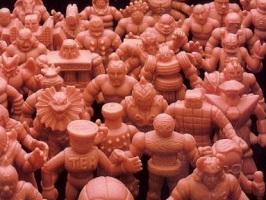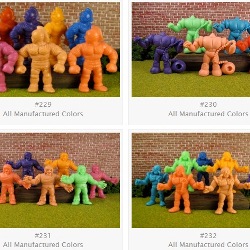UofMUSCLE.com – M.U.S.C.L.E. Figures from Mattel
Archeology 200 – The 2009 M.U.S.C.L.E. investigation
In 2003 the first documented attempt to uncover factual data from Mattel took place. It uncovered some new information, but did not provide definitive answers. While all the leads had seemingly disappeared, there was still continued research. The new goal was to find Mattel employees that had worked at Mattel during the production of M.U.S.C.L.E.
Connections with Mattel employees were made again and again. Those connections often ended with the same results: (1) the employee was at Mattel after M.U.S.C.L.E.; and/or (2) the employee had zero knowledge or understanding of “that side” of the business.
The first major discovery was in early 2009 from a toy industry insider – who requested to remain anonymous, and will be referenced as Jan09. He had an accomplished background in the toy industry and was very familiar with the inner workings of Mattel.
Jan09 stated that Mattel was feeling frustrated. Toys were being brought over from Japan and becoming a success in the United States. Mattel wanted a “Transformers” and they wanted a low cost item. M.U.S.C.L.E. fit these criteria perfectly.
This certainly did not endure the item to people within Mattel. The employees hated M.U.S.C.L.E. There is very little opportunity for creativity when a toy is simply being repacked. With designers essentially out of the picture the product landed squarely with marketing. Jan09 said that Marketing would have been the central force behind M.U.S.C.L.E. He also stated that Marketing is often the central force behind most products, a sentiment that has been repeated in numerous interviews with numerous individuals. Jan09 stated that planning a new product launch takes approximately 9~12 months, although it could have been shorter because it was an existing toy.
M.U.S.C.L.E.’s first appeared on retailers shelves in late 1985. This means that Mattel’s 1986 Toy Fair catalog, featuring M.U.S.C.L.E. for the first time, would need to have been completed in the summer of 1985 for presentation at the 1986 Toy Fair.
Jan09 said the Mattel released M.U.S.C.L.E. as a “semi-collectible type figure,” which is why there was a poster featuring the figures. He said Mattel was truly revolutionary with many things, but they had not mastered collectibility – at that point. This is why he felt Super Rares were not chase figures, Mattel was not savvy enough to implement that tactic.
He stated, as previously knows, that the toys would have been made in Japan and/or China. He said that everything would have happened there. Figures would have left the factories ready for placement on store shelves.
Jan09 also talked about Mattel’s strict quality. Mattel would have provided Bandai with the color codes for the pellets used in the injection molding and Bandai would have to comply. He said Mattel would reject hundreds of thousands of toys if the figures didn’t meet production specs. This is a very likely explanation of why there is not vast color variation in MUSCLE figures, unlike other little rubber figures (e.g., Garbage Pail Kids). He also said the sharp pieces, small pieces, knifes, and skulls are usually “red flags” for Mattel. This could lend credence to the theory that some figures were pulled because of these characteristics (e.g., Satan Cross).
The last topic of discussion with Jan09 was production. He said that the average toy has a 200,000 stock-keeping unit (SKU) count. That’s 200,000 boxes of said toys. For M.U.S.C.L.E. one SKU could be a 4-pack box, which held 72 4-packs. Jan09 said a launch sometimes only has 16,000 SKUs, but that a low cost item might get 400,000 to 800,000.
Jan09’s finally contribution was the contact information of former Mattel employees that may have worked on M.U.S.C.L.E. It turned out that only one person was able to help, and it was Martin Arriola. As stated on his webpage:
Martin F. Arriola was born and raised in Los Angeles, California.
He attended Art Center College of Design, Pasadena as an Illustration Major.
Martin has designed and developed products for Mattel Inc. for the past 25 years.
Martin was one of the nicest and most open people to ever talk about Mattel and M.U.S.C.L.E. During the interview his focus was on his current project, Mattel’s Disney Pixar die-cast Cars. One example of his work can be seen here: Cars’ Blu-Ray McQueen
Martin first talked about when and how he first became aware of MUSCLE. He had been brought into Mattel to be involved with the continued design of He-Man. He was essentially the replacement for Mark Taylor, the original creator of He-Man. He first heard of M.U.S.C.L.E. because the VP of Design was sending people to Japan for a month to set-up in an apartment and brainstorm. He believed Dave Wolfram was one of the people sent to Japan. He jokingly said the slackers were sent because he had work to do. Martin said nothing ever came from those sessions.
While Martin never worked on M.U.S.C.L.E. directly he was very aware of its presence as part of Mattel’s boys action-figure group. MUSCLE was seen as a “flanker brand.” Its job was to protect the core brands (e.g., He-Man). Around the time of M.U.S.C.L.E. Mattel had been very focused on acquiring the DC property. Ultimately it went to Kenner and became the Super Powers Collection. In its place Mattel focused on Marvel’s Secret Wars – keeping M.U.S.C.L.E. in its flanker brand role. He said that there was not a lot of effort put into MUSCLE because it was a flanker brand.
Even though Playthings magazine had listed M.U.S.C.L.E. as a top selling toy in 1986 Martin said there was no feeling of excitement around the brand within Mattel. He remembered the focus of the time being set on He-Man and the development of Captain Power.
When he was asked about the timeline for creating the M.U.S.C.L.E. entry in the catalog, based on Jan09’s statements, he said he thought that timeline seemed right. He emphasized the fact that catalogs were done much differently back in the eighties. There was not any Photoshop or computers. Pictures were taken about a year ahead of time. He did note that it was possible that the pictures were taken later because they were simply getting the figures from Bandai.
In 1987 Mattel “maximized its core brands and tried to identify new core brands.” The partnership with Bandai likely stopped M.U.S.C.L.E. from being considered a core brand. Martin said it would be hard to say if Mattel would have likely continued MUSCLE in another scenario. He cited a Cars property that he had been working on that was making $20 million. It was not enough for Mattel and the line was discontinued. In the mid-80’s it is difficult to imagine what M.U.S.C.L.E. was making or what it would have taken to save it.
The discussion shifted to Mattel’s production practices. When asked about the likelihood of, during the 80’s, Mattel producing all the toys for a line in roughly 3 months and the average SKU count being roughly 200,000 pieces he felt like it was a likely average across all brands.
When asked about the possibility that 400,000 to 800,000 SKU’s would be created for a low cost item like M.U.S.C.L.E. he thought that it was very unlikely. Martin stated that those numbers were very high, especially for boys toys – he stated they were “Barbie numbers.”
Without knowing the specifics of the molds it was very difficult for Martin to discuss some specifics. He was unable to offer any insight into how figures were designated for 4-, 10-, and 28-packs, but stated that there had to have been a system. Mattel would be concerned with putting two of one figure in a package, and a system would prevent that from happening. He did state that the injection molding trees would help create that system and that bins would be used because they would be produced so quickly. This speedy production would make it highly unlikely that only one of any figure would be produced.
Martin had some additional insights into the Super Rare figures. He knew that they could not have been “chase” figures because the concept had not been developed yet. He also said that he did not know of any recall or internal discontinuation, but that someone would have to be on the M.U.S.C.L.E. team to know that information. It is also possible that a member of the Marketing team simply disliked a figure. They would have had the influence and control to simply cut a figure from the collection.
The last topic of discussion was the partnership between Mattel and Nestle. Martin believed that Mattel likely approached Nestle about the Quik promotion, mainly because there were so few parties involved. He said marketing tie-in things like that are sometimes out of Mattel’s control. For example, Disney would set-up any promotions for a Cars tie-in with Coke, Burger King, etc. – not Mattel.
Both Martin and Jan09 provided additional contact opportunities. Hopefully one day the M.U.S.C.L.E. community will uncover those elusive Mattel employees that were responsible for bringing M.U.S.C.L.E. to the United States and Canada.

